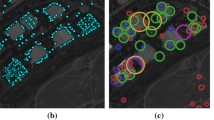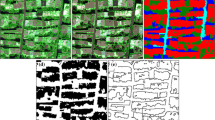Abstract
In this paper, a new building detection scheme using semi-supervised edge learning is proposed. This scheme utilizes a feature based on edge flow to delineate the patterns of sharp contrast at the edges of building. The contrast patterns with their distribution in the features space based on similarity metric provide discriminative evidences for the building detection. By the extended kernelBoosting, the semi-supervised edge learning, a number of Gaussian Mixture Models (GMMs) are computed and optimized to model the local distribution of contrast patterns according to their similarity. The ‘weak kernel’ hypotheses are then generated from these optimized Gaussian Mixture Models. The final kernel is defined by accumulating a weighted linear combination of such “weak kernel”. The kernel function can then be used for classification with kernel SVM. Experiments show that this scheme is capable of achieving both low false positive rate and low false negative rate with only a few training examples and that this method can be generalized to many object classes.
Preview
Unable to display preview. Download preview PDF.
Similar content being viewed by others
References
Mayer, H.: Automatic object extraction from aerial images – A survey focusing on buildings. Journal on Computer Vision and Image Understanding 74, 138–149 (1999)
Lin, C., Nevatia, R.: Building Detection and Description from a Single Intensity Image. Journal on Computer Vision and Image Understanding 72, 101–121 (1998)
Noronha, S., Nevatia, R.: Detection and Modeling of Buildings from Multiple Aerial Images. IEEE Transaction on PAMI 23, 501–518 (2001)
Krishnamachari, S., Chellappa, R.: Delineating buildings by grouping lines with MRFs. IEEE Transaction. on Pat. Anal. Mach. Intell. 5, 164–168 (1996)
Katartzis, A., Sahli, H., Nyssen, E., Cornelis, J.: Detection of Buildings from a Single Airborne Image using a Markov Random Field Model. In: IEEE International Geoscience and Remote Sensing Symposium (IGARSS 2001), vol. 6, pp. 2832–2834 (2001)
Iqbal, Q., Aggarwal, J.K.: Applying perceptual grouping to content-based image retrieval: Building images. In: IEEE Int. Conf. on CVPR, vol. 1, pp. 42–48 (1999)
Bradshow, B., Scholkopf, B., Platt, J.C.: Kernel Methods for Extracting Local Image Semantics. Tech. Report MSR-TR-2001-99, Microsoft Research (2001)
Henricsson, O.: The Role of Color Attributes and Similarity Grouping in 3-D Building Reconstruction. Journal on Computer Vision and Image Understanding 72, 163–184 (1998)
Kumar, S., Hebert, M.: Man-Made Structure Detection in Natural Images using a Causal Multiscale Random Field. In: IEEE International Conference on Computer Vision and Pattern Recognition (CVPR), vol. 1, pp. 119–126 (2003)
Kumar, S.: Models for Learning Spatial Interactions in Natural Images for Context-Based Classification. CMU-CS-05-28, Robotics Institute (2005)
Kumar, S., Hebert, M.: Discriminative Fields for Modeling Spatial Dependencies in Natural Images. In: IEEE Conf. on advances in Neural Information Processing Systems, NIPS (2003)
Ma, W.Y., Manjunath, B.S.: Edge flow: a framework of boundary detection and image segmentation. In: IEEE Conf. on Computer Vision and Pattern Recognition (1997)
Hertz, T., Bar-Hillel, A., Weinshall, D.: Learning a Kernel Function for Classi_cation with Small Training Samples. In: International Conference on Machine Learning (2006)
Shental, N., Bar-Hillel, A., Hertz, T., Weinshall, D.: Computing Gaussian mixture models with EM using equivalence constraints. In: Advances in Neural Information Processing Systems, vol. 16, pp. 465–473. MIT Press, Cambridge (2004)
Belongie, S., Malik, J., Puzicha, J.: Shape Matching and Object Recognition Using Shape Contexts. IEEE Transation on Pattern Analysis and Machine Intelligence, 24509–24522 (2002)
Bar-hillel, A., Hertz, T., Shental, N., Weinshall, D.: Learning distance functions using equivalence relations. In: International Conference on Machine Learning, ICML (2003)
Wang, L., Shi, J., Song, G., Shen, I.: Object Detection Combining Recognition and Segmentation. In: Yagi, Y., Kang, S.B., Kweon, I.S., Zha, H. (eds.) ACCV 2007, Part I. LNCS, vol. 4843, pp. 189–199. Springer, Heidelberg (2007)
Author information
Authors and Affiliations
Editor information
Editors and Affiliations
Rights and permissions
Copyright information
© 2008 Springer-Verlag Berlin Heidelberg
About this paper
Cite this paper
Yang, F., Duan, Y., Lu, Y. (2008). Semi-supervised Edge Learning for Building Detection in Aerial Images. In: Bebis, G., et al. Advances in Visual Computing. ISVC 2008. Lecture Notes in Computer Science, vol 5359. Springer, Berlin, Heidelberg. https://doi.org/10.1007/978-3-540-89646-3_10
Download citation
DOI: https://doi.org/10.1007/978-3-540-89646-3_10
Publisher Name: Springer, Berlin, Heidelberg
Print ISBN: 978-3-540-89645-6
Online ISBN: 978-3-540-89646-3
eBook Packages: Computer ScienceComputer Science (R0)




